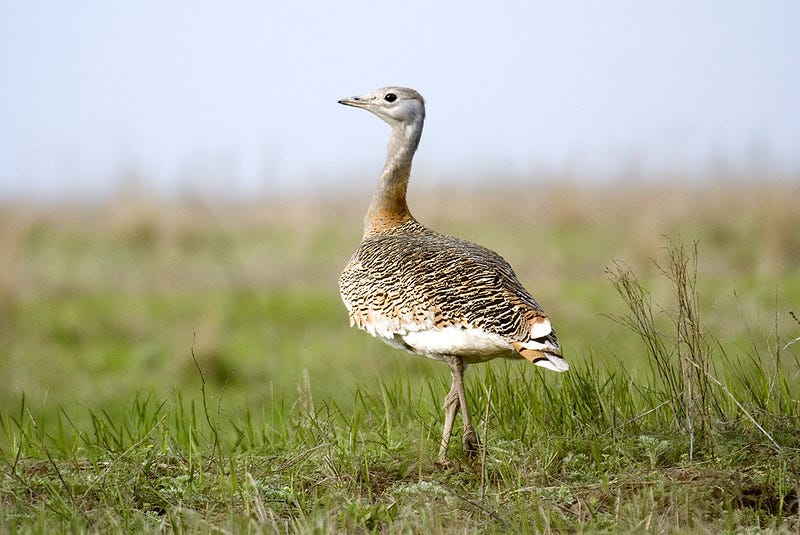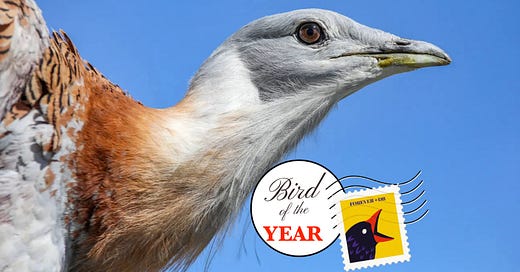Bird of the Year: Great Bustard
A bird so good, I’ve been thinking about it for 12 months straight.
This is our last post of 2023. See you in 2024.
Well friends, we’ve made it through another year. Don’t worry, I’m not going long on 2023. It had a few highs, some devastating lows, and a great many soul-soothing, miraculous birds.
This year, I came to terms with the fact that I’m at a moment in my life (aka my mid-30s) where I’ve started to regress in a few particular ways. I’m embracing music and style choices from my teens, resurfacing photos from years ago and examining them with a puzzled brow, and re-reading terrible writing from my mid-20s (I don’t recommend it). I’m not entirely sure why I’m doing this. Maybe it’s because we were all effectively frozen in time for a few years. As the ice thaws, I find myself with one eye on the past as the inevitable future marches us forward.
This creeping tendency to look back even applies to the storied birds of Discourse Blog. When Jack asked me if I could do Bird of the Year again this year, I eagerly and happily accepted. Then I spent several days grappling with what felt like a cheat in the quest to choose a bird worthy of the honor. The truth is, I did no research to make my determination. I didn’t even look at my personal list of potential Bird of the Week options. Nope. I went with a bird I mentioned in last year’s Bird of the Year blog. A bird I’ve been thinking about ever since I first wrote about it in December 2022. I mean, why fight the past when the past has made itself present? The mere existence of this bird in my mind made it clear that it was the only choice.
So without further ado: Discourse Blog’s 2023 Bird of the Year is the previously mentioned, possibly snubbed (???), “drug-taking, safe sex icon”: the great bustard. All hail!!!
Let’s address the “drug-taking, safe sex icon”-shaped elephant in the room. Buckle up. Great bustards (yes I did write “bastards” about 10 times on accident while writing this) are what’s known as lek breeders (something we’ve written about before) which basically means that during mating season, all the men gather ‘round to put on a horny, raucous show for the ladies. The females observe the competitive displays and make their choices. This isn’t just a superficial display either. Let me quote New Scientist here:
“They also present their cloaca – the common opening for their digestive, urinary and reproductive tracts – to females, who appear to “examine” the orifice and even peck at it, possibly looking for signs of infection.”
Okay then! And what has this long tradition led to? Well, “Super-sized males with striking red coloration, capable of performing a complex display involving contortion of the body and inflation of a specialized throat sac.”
Okay then! This is already a nice bit of romantic courtship in the often hostile animal world, but it doesn’t stop there. Last year, researchers in Spain put forth the theory that two of the plants consumed by great bustards—corn poppies and purple viper’s bugloss—might be eaten as a form of self-medication. Both plants contain antiparasitic compounds, and the purple viper’s bugloss has antifungal agents as well. The researchers also noted that the great bustards consumed these plants in higher numbers during mating season.
While the theory hasn’t been proven, even the mere possibility (and a strong one at that) that these birds are combating sexually transmitted infections with natural medicine is astounding. Self-medicating behavior is a trait that’s usually associated with primates but no, it’s a survival tactic that’s also “for the birds!” (if that phrase meant the opposite of what it means).
Great bustards reside in Europe, Africa, and Asia, and they’re listed as endangered on the International Union for Conservation of Nature’s Red List of Threatened Species. They were actually hunted to extinction in the UK, and there are now efforts to reintroduce the vulnerable species back into the ecosystem. Great bustards are also famously elusive, and honestly, I would be too if a bunch of monstrous humans hunted me for sport and destroyed my habitat. It’s a trait they share with 2022’s Bird of the Year, the black-naped pheasant-pigeon, which I guess reveals my propensity for mysterious freaks. I won’t apologize for being into goth birds.
Did I mention that on top of all this, great bustards are one of the world’s heaviest flying birds? Come on, that’s hilarious and amazing. These guys are HUGE, and when I say guys, I mean guys. Great bustards display some of the most dramatic sexual dimorphism among living animals on earth—at least when it comes to size. Males can weigh as much as 40 pounds and to an 8-foot wingspread, while females are about half big and half as heavy. It’s a fact that makes the female-led mating rituals all the more admirable.

I know we’ve all evolved beyond “absolute unit” but I’d be lying if I said that phrase didn’t cross my mind while scrolling through countless photos of great bustards. But even with the still shots and vivid descriptions of their size, it’s hard to understand how big these babies really are. Take a peek:
Beautiful! Look. I really try to resist handing over my job to someone else, but the prose on eBird is just pristine:
Huge, unmistakable, regal bird of treeless open plains and natural steppes, occupying some low-intensity agricultural areas. Walks in a stately manner, but may run rather than fly if disturbed. Flight is heavy and gooselike. Highly gregarious, especially in winter. Males are much larger than the females and the sexes do not mix much outside of the breeding season. Spectacular "foaming bath" display at leks (display sites) as males bristle their body and wing feathers forward, turning them white, while burying their head in the plumage.
Last but not least, we have to talk about the name. Great bustards. Now, a rose by any other name would smell as sweet and these birds don’t recognize the English language let alone the name we’ve given them, but still: great bustards!! Great name, great bird. I highly encourage you to just say it out loud to yourself right now. When I told my husband who we were crowning Bird of the Year he said, “GREAT BUSTARDS!!! I don’t even need to see a photo, I love them already.” Then he walked out of the room gently repeating, “great bustards….” Great bustards!
Before I sign off, I feel I must note here that I recently stumbled upon the news that New Zealand not only crowns its own Bird of the Year (and has been doing so since 2005), they recently named the Bird of the CENTURY and the whole thing got worldwide attention because the winner was championed by John Oliver?? The pūteketeke or the “puking bird” took home the prize, with the kea (beloved by this blog) coming in second. I won’t argue with that choice or the spirit of the mission. There’s plenty of room in this world for made-up distinctions in the name of bird conservation, and the puking bird does indeed rule.
I hope great bustards are with us for many years to come. They are a true safe sex role model, a force for good, and they contain multitudes underneath their relatively straightforward exterior. And if you’re hungry for more of that sweet, sweet bustard, please look at these photos of great bustards trotting and strutting their stuff. Great bustards might be elusive and respectful, but they’re not humble. I wouldn’t have it any other way.
We’ll see you again in 2024! Thanks for birding with us all year long. Please keep sending us your bird rants and raves at hello@discourseblog.com and remember, you can check out our complete Bird of the Week list here.







